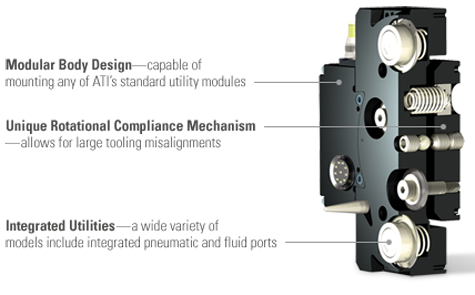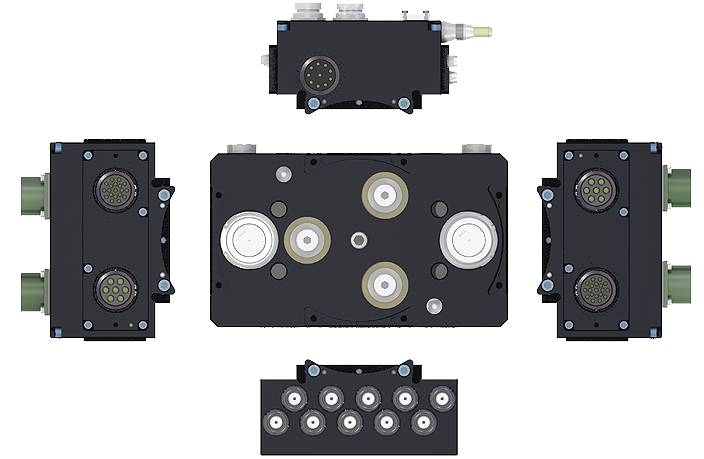ATI Utility Couplers are for applications where there is a need to quickly connect utilities such as air, fluid, power and electrical signals in docking and fixturing applications. The modular, multi-coupling design can attach any of ATI’s standard add-on utility modules and will improve cycle time and flexibility in any production cell. The Master-side connection features a unique rotational compliance mechanism that allows for large tooling misalignments. Utility Couplers can be provided with an electric or air actuated drive cylinder. ATI Utility Couplers offer a quick and cost-effective solution to your challenging coupling needs.
- Built-in engineered rotational compliance ensures reliable coupling
- Common mounting flats attach standard ATI utility modules
- Integrated air ports available
- DeviceNet, Ethernet, or PROFINET compatible
- Drive Cylinders and Linear Actuators available
- Tool-side presence sensors available
|

|
|
|
|
|
Utility Couplers usually feature an anodized aluminum body, a hardened stainless steel alignment pin system, and hardened-steel overload pins. There is usually no locking mechanism in the unit. Instead, the device depends on force from an optional drive cylinder or linear actuator to maintain constant coupling pressure. ATI supplies drive cylinders or linear actuators as required for specific applications. It is important to correctly size the correct drive cylinder for your application. Considerations must be made to account for the counteracting forces from the integrated checked ports when sizing your drive cylinder. The Utility Coupler models page shows compatible drive cylinder assemblies for each Coupler style. In addition, specific drive cylinders can be supplied upon request. It is important to keep in mind the relatively high push forces that the drive cylinders will have when designing the surrounding fixtures.
|
|
|
|
Utility Couplers have a unique compliance feature built into the Master-side that allows for 4 mm compliance in any direction in the coupling plane. Also, it allows for ± 3 degrees rotational compliance. There are three pairs of preloaded springs internal to the housing that force the main body to self-center on custom chamfered thrust bearings. This system allows for a relatively large misalignment of the Master and Tool prior to coupling. For applications that need greater compliance, please contact ATI and we can engineer a customized solution. ATI Utility Couplers can also be rigid. The rigid couplers offer a low-cost solution for connecting air or electric utilities and are well-suited for applications where the corresponding fixtures can be well aligned.
|
|
|
|
ATI Utility Couplers are compatible with a large number of standard ATI utility modules, with the ability to function in a wide variety of applications. This flexibility is due in large part to the many different models of utility modules that have been developed for ATI Tool Changers over the past several years. The Master and Tool bodies are equipped with module mounting features that enable the coupler to connect up to four additional standard Tool Changer utility modules. The Master and Tool bodies can come with optional built-in features that quickly connect multiple utilities from the Master to the Tool-side.
There are some special considerations that are necessary when adding air or fluid modules. Each fluid/air port provides some amount of push-back force, which needs to be quantified when specifying the drive cylinder. Larger checked ports exert large forces on the coupler that must be overcome in order to ensure a flush connection. Furthermore, if the Utility Coupler is configured with a large number of fluid/air ports all on one side of the assembly, the resulting push-back forces will be uncentered and may result in the need for a larger drive cylinder. If you want to add additional fluid/air modules onto the coupler beyond the number of integrated ports, contact ATI for application assistance.
Information on our add-on modules can be found
here.
|

Utility Coupler module-to-body connection (Model G2)
|
|
|
|
|
|
|
|
|
|
|
|
|
|
|
|
|
|
|
|
|